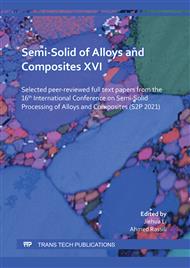[1]
P.B. Kapranos, D. Midson, S.P. Naher, S. Haga, T., Advanced Casting Methodologies: Inert Environment Vacuum Casting and Solidification, Die Casting, Compocasting, and Roll Casting, in: S. Hashmi, G.F. Batalha, C.J. Van Tyne, B. Yilbas (Eds.), Comprehensive Materials Processing, Elsevier, Oxford, (2014).
DOI: 10.1016/b978-0-08-096532-1.00503-3
Google Scholar
[2]
European Aluminium Association, Aluminium Automotive Manual, Manufacturing casting methods.https://www.european-aluminium.eu/media/1526/aam-manufacturing-1-casting-methods.pdf, (accessed 28/04/2021.2021).
Google Scholar
[3]
H.V. Atkinson, Modelling the semisolid processing of metallic alloys, Prog. Mater. Sci. 50(3) (2005) 341-412.
Google Scholar
[4]
H. Bikas, P. Stavropoulos, G. Chryssolouris, Additive manufacturing methods and modelling approaches: a critical review, Int. J. Adv. Manuf. Tech. 83(1) (2016) 389-405.
DOI: 10.1007/s00170-015-7576-2
Google Scholar
[5]
N.T. Aboulkhair, M. Simonelli, L. Parry, I. Ashcroft, C. Tuck, R. Hague, 3D printing of Aluminium alloys: Additive Manufacturing of Aluminium alloys using selective laser melting, Prog. Mater. Sci. 106 (2019) 100578.
DOI: 10.1016/j.pmatsci.2019.100578
Google Scholar
[6]
Y. Kok, X.P. Tan, P. Wang, M.L.S. Nai, N.H. Loh, E. Liu, S.B. Tor, Anisotropy and heterogeneity of microstructure and mechanical properties in metal additive manufacturing: A critical review, Mater. Des. 139 (2018) 565-586.
DOI: 10.1016/j.matdes.2017.11.021
Google Scholar
[7]
A. Pola, M. Tocci, P. Kapranos, Microstructure and Properties of Semi-Solid Aluminum Alloys: A Literature Review, Metals 8(3) (2018).
DOI: 10.3390/met8030181
Google Scholar
[8]
A.R. Anilchandra, L. Arnberg, F. Bonollo, E. Fiorese, G. Timelli, Evaluating the Tensile Properties of Aluminum Foundry Alloys through Reference Castings—A Review, Materials 10(9) (2017).
DOI: 10.3390/ma10091011
Google Scholar
[9]
Y. Birol, F. Birol, Wear properties of high-pressure die cast and thixoformed aluminium alloys for connecting rod applications in compressors, Wear 265(5) (2008) 590-597.
DOI: 10.1016/j.wear.2007.12.004
Google Scholar
[10]
L. Lasa, J.M. Rodriguez-Ibabe, Effect of composition and processing route on the wear behaviour of Al–Si alloys, Scr. Mater. 46(6) (2002) 477-481.
DOI: 10.1016/s1359-6462(02)00020-9
Google Scholar
[11]
C.H. Hager, A.E. Segall, J.C. Conway, H. Dang, M.F. Amateau, Evaluation of the Reciprocating-Wear Behavior of Unlubricated Hypereutectic Al-Si Alloys, Tribol. Trans. 46(2) (2003) 206-210.
DOI: 10.1080/10402000308982618
Google Scholar
[12]
A.K. Dey, P. Poddar, K.K. Singh, K.L. Sahoo, Mechanical and wear properties of rheocast and conventional gravity die cast A356 alloy, Mat. Sci. Eng. A 435-436 (2006) 521-529.
DOI: 10.1016/j.msea.2006.07.148
Google Scholar
[13]
M.A. Bayoumi, M.I. Negm, A.M. El-Gohry, Microstructure and mechanical properties of extruded Al–Si alloy (A356) in the semi-solid state, Mater. Des. 30(10) (2009) 4469-4477.
DOI: 10.1016/j.matdes.2008.11.025
Google Scholar
[14]
A. Vencl, I. Bobić, Z. Mišković, Effect of thixocasting and heat treatment on the tribological properties of hypoeutectic Al–Si alloy, Wear 264(7) (2008) 616-623.
DOI: 10.1016/j.wear.2007.05.011
Google Scholar
[15]
N.V. Thuong, H. Zuhailawati, A.A. Seman, T.D. Huy, B.K. Dhindaw, Microstructural evolution and wear characteristics of equal channel angular pressing processed semi-solid-cast hypoeutectic aluminum alloys, Mater. Des. 67 (2015) 448-456.
DOI: 10.1016/j.matdes.2014.11.054
Google Scholar
[16]
D.K. Dwivedi, Adhesive wear behaviour of cast aluminium–silicon alloys: Overview, Mater. Des. (1980-2015) 31(5) (2010) 2517-2531.
DOI: 10.1016/j.matdes.2009.11.038
Google Scholar
[17]
R. Casati, M. Vedani, Aging Response of an A357 Al Alloy Processed by Selective Laser Melting, Adv. Eng. Mater. 21(4) (2019) 1800406.
DOI: 10.1002/adem.201800406
Google Scholar
[18]
N. Kang, P. Coddet, H. Liao, T. Baur, C. Coddet, Wear behavior and microstructure of hypereutectic Al-Si alloys prepared by selective laser melting, Appl. Surf. Sci. 378 (2016) 142-149.
DOI: 10.1016/j.apsusc.2016.03.221
Google Scholar
[19]
G. Hirt, R. Kopp, Thixoforming: Semi-solid Metal Processing, Wiley‐VCH Verlag GmbH & Co., (2009).
Google Scholar
[20]
W.E. Frazier, Metal Additive Manufacturing: A Review, J. Mater. Eng. Perform 23(6) (2014) 1917-1928.
Google Scholar
[21]
J. Wu, X.Q. Wang, W. Wang, M.M. Attallah, M.H. Loretto, Microstructure and strength of selectively laser melted AlSi10Mg, Acta Mater. 117 (2016) 311-320.
DOI: 10.1016/j.actamat.2016.07.012
Google Scholar
[22]
N.T. Aboulkhair, N.M. Everitt, I. Ashcroft, C. Tuck, Reducing porosity in AlSi10Mg parts processed by selective laser melting, Addit. Manuf. 1-4 (2014) 77-86.
DOI: 10.1016/j.addma.2014.08.001
Google Scholar
[23]
L. Girelli, M. Tocci, M. Gelfi, A. Pola, Study of heat treatment parameters for additively manufactured AlSi10Mg in comparison with corresponding cast alloy, Mat. Sci. Eng. A 739 (2019) 317-328.
DOI: 10.1016/j.msea.2018.10.026
Google Scholar
[24]
C. Weingarten, D. Buchbinder, N. Pirch, W. Meiners, K. Wissenbach, R. Poprawe, Formation and reduction of hydrogen porosity during selective laser melting of AlSi10Mg, J Mater Process Technol. 221 (2015) 112-120.
DOI: 10.1016/j.jmatprotec.2015.02.013
Google Scholar
[25]
R.X. Li, R.D. Li, Y.H. Zhao, L.Z. He, C.X. Li, H.R. Guan, Z.Q. Hu, Age-hardening behavior of cast Al–Si base alloy, Mater. Lett. 58(15) (2004) 2096-2101.
DOI: 10.1016/j.matlet.2003.12.027
Google Scholar
[26]
A. Hadadzadeh, B.S. Amirkhiz, M. Mohammadi, Contribution of Mg2Si precipitates to the strength of direct metal laser sintered AlSi10Mg, Mat. Sci. Eng. A 739 (2019) 295-300.
DOI: 10.1016/j.msea.2018.10.055
Google Scholar
[27]
W.H. Kan, Y. Nadot, M. Foley, L. Ridosz, G. Proust, J.M. Cairney, Factors that affect the properties of additively-manufactured AlSi10Mg: Porosity versus microstructure, Addit. Manuf. 29 (2019) 100805.
DOI: 10.1016/j.addma.2019.100805
Google Scholar
[28]
R. Franke, I. Haase, M. Klemm, R. Zenker, Friction and wear behaviour of electron beam surface treated aluminium alloys AlSi10Mg(Cu) and AlSi35, Wear 269(11) (2010) 921-929.
DOI: 10.1016/j.wear.2010.08.002
Google Scholar
[29]
G. Straffelini, A. Molinari, Dry sliding wear of Ti–6Al–4V alloy as influenced by the counterface and sliding conditions, Wear 236(1) (1999) 328-338.
DOI: 10.1016/s0043-1648(99)00292-6
Google Scholar


